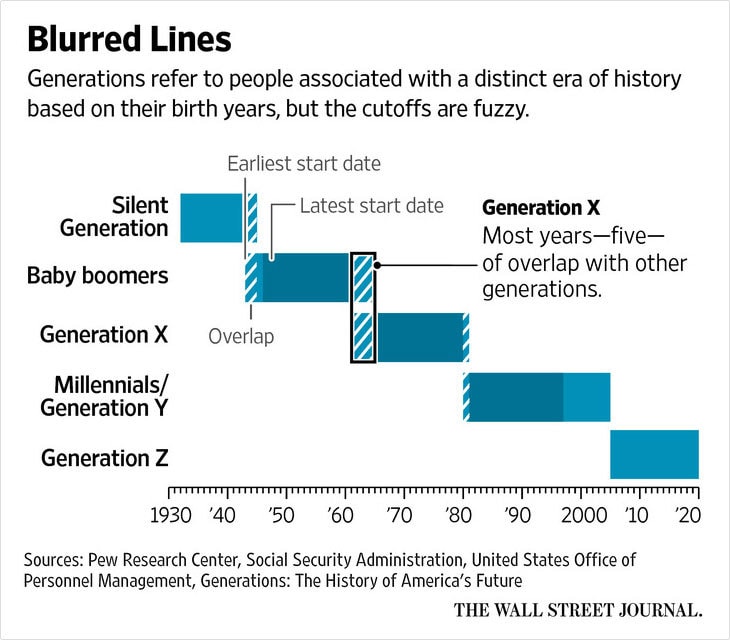Introduction
In the news and on social media, it seems like there’s a war raging between the generations. Baby Boomers have accused Millennials of ruining classic industries such as the golf industry, the diamond industry, and even the movie business. And Millennials have blamed Baby Boomers for the current state of the housing market, climate change, and Brexit.
Luckily, all the online finger-pointing doesn’t have to spill over into the workplace. Despite their differences and disagreements, Millennials, Gen X, Baby Boomers, and more, can come together to create dynamic and effective teams. And managing these teams can be a very rewarding experience.
Proactively navigating generational differences in the workplace will help you better understand, communicate with, and lead a multigenerational workforce. Use the following tips for managing multigenerational teams to help you harness the best of these powerful generations.
Generations: Why Do They Matter?
The workforce is constantly changing. As one generation moves on towards retirement, another enters the working landscape, bringing a new set of values, priorities, and expectations along with them. Here are some of the benefits of educating employees and management on the similarities and differences of the generations that make up the modern workforce.
- Make Your Company More Appealing to Each Generation
Understanding the idiosyncrasies of each generation allows companies to develop effective strategies for focusing on generation-specific needs. With this knowledge, companies can establish best practices for recruiting, retaining, and motivating different age groups.
- Alleviate Intergenerational Friction and Conflict
The importance of intergenerational understanding isn’t limited to tailoring the workplace experience to different age groups. According to a study of 1,350 employees, more than one in three workers report wasting five or more hours weekly due to unaddressed conflicts with colleagues from other generations (that’s 12 percent of their work week).Organizations that address generational differences and similarities head-on increase the intergenerational understanding necessary to alleviate this employee pain point.
- Gain a Competitive Edge
A workforce that is less caught up in the trappings of conflict will have more valuable opportunities for innovation, collaboration, and growth. Intergenerational collaboration makes organizations more effective, and results in better decision making thanks to the wider pool of worldviews that these organizations can draw from. Over time, these factors transform a company into a more competitive organization overall.
- Avoid Brain-Drain Before It’s Too Late
According to a recent CIPD study, less than one-third of organizations report having an HR strategy in place for managing their aging workforce. By encouraging increased intergenerational understanding and partnership, companies can transfer the knowledge possessed by older generations onto younger generations before they retire.
- Reduce Stereotyping and Ageism
Discrimination in the office makes for an unpleasant experience for everybody. Just as it is important to fight racism, sexism, and homophobia in the workplace, it is important to increase intergenerational appreciation to reduce ageism. By debunking harmful generational stereotypes, employees will be able to see one another as teammates, rather than two-dimensional members of a certain age group.
Traditionalists to iGen: A Generational Overview
Naming generations is a messy business. Overall, experts tend to disagree on where each generation starts and ends. And, over time, the cut-off dates for each generation are subject to change, as that generation becomes better understood by researchers.
Source: The Wall Street Journal
Generation names and markers also tend to vary from East to West, and from country to country. In the United States, the workforce today is made up of 3 main generations: Baby Boomers, Generation X, and Generation Y (or as they are popularly known, Millennials).
While these three generations make up the bulk of the workforce, it’s important to consider the oldest outgoing generation, as well as the incoming generation that is on the horizon. These two groups are called the Silent Generation and Generation Z.
Here is what to know about each of these generations, and what their role is in the working world.
1. Silent Generation (Traditionalists)
Born from the mid 1920’s to the early-to-mid 1940’s, the “Traditionalist” or Silent Generation is the oldest living generation still active in today’s workforce. Influenced by the Great Depression and World War 2, the Silent Generation is characterized by being conservative and disciplined, with a strict adherence to the rules and a strong sense of duty and obligation.
2. Baby Boomers
Baby Boomers were born as part of the post-World War II baby boom that took place from the early-to-mid 1940’s through the early-to-mid 1960’s (or, as most sources specify, from 1946-1964.) The historical influences on this generation include the moon landing, the Cold War, the Civil Rights movement, the Vietnam War, and JFK’s Assassination. Post-World War II optimism inspired a sense of stability, opportunity and prosperity for this generation. Because so many different events happened in this 20-year span, the Baby Boom Generation is sometimes further divided into two categories: Boomers I (or the Baby Boomers) and Boomers II (or Generation Jones). Lumped together, the youngest Baby Boomers are currently entering their mid 50’s, while the oldest are entering their mid 70’s.
3. Generation X
Generation X, also known as “Gen X” for short, is the generation born from the early-to-mid 1960’s to the early 1980’s. Sometimes known as the “baby bust” generation, Gen Xers were born in the lull following the baby boom that came before them. Generation X has also been referred to as the “lost” generation, or the “middle child” generation, for being smaller in numbers and receiving less coverage than the generations that precede or follow it. Born in the age of Disco and eventually MTV, Gen Xers were marked by Watergate, Chernobyl, the Sexual Revolution, the falling of the Berlin Wall, and the AIDS epidemic. Gen Xers also grew up at a time when divorce rates reached a new high, and many grew up with two working parents, making this generation largely independent.
4. Generation Y (Millennials)
Generation Z, sometimes referred to as the iGen, is the youngest generation currently entering the workforce. Born roughly from the late 1990’s or early 2000’s to 2012, early Gen Zers are often lumped in with Millennials because of the fuzzy nature of this generation’s start date. While Millennials watched the rise of the internet, most members of Generation Z have been connected their whole lives, making them even more technologically savvy than their predecessors. Generation Z saw the collapse of the housing market the rise in student loan debt, the rise of social movements like Black Lives Matter, and the popularization of Uber and the gig economy. Although previously in the shadow of Millennials, Generation Z recently shot into the spotlight with the Parkland shooting survivors, a group of Gen Z activists protesting for gun law reform.
5. Generation Z (iGen)
Members of Generation Y, popularly known as Millennials, were born roughly from the early 80’s to the late 1990’s or early 2000’s. Although experts don’t always agree on the start and end dates of this generation, they agree on one thing: this generation grew up at a time that was marked by the internet. The oldest American Millennials remember the Columbine shootings and 9/11, while younger members remember the Iraq War and Hurricane Katrina. Children of the Baby Boomers, many Millennials grew up with close supervision and abundant, optimistic, parental support of their goals.
What Do These Generations Bring to the Workplace?
So, what does this mean for companies? The unique historical happenings, political climates, and family dynamics that shaped each generation molded not only their members’ world views, but also each generation’s communication styles, management preferences, and workplace priorities. Here is what the members of each of today’s active generations often contribute to – and expect from – the workplace.
1. The Silent Generation (Traditionalists)
Largely retired, the Silent Generation makes up only 2 percent of today’s workforce. Those who are still working are among the oldest members of their organizations, and as a result often hold powerful positions, such as president of the board of directors.
As authority figures, Traditionalists are often very past-oriented. They prefer hierarchical organizational structures, and may possess a command-and-control leadership style that is reminiscent of military operations. They are committed to their organization’s founding goals and beliefs.
In the office, members of the Silent Generation are known for being loyal and committed employees. They have a strong respect for authority, as well as a strong sense of right and wrong. They are dedicated and focused, and view work as a privilege. Traditionalists are often uncomfortable with conflict, and therefore may not be forthcoming about their disagreements with others.
Traditionalists prefer managers that are direct and specific in their instructions and expectations. They want clear long-term goals from management, and expect consistency and fairness. This generation takes a logical approach to tasks and challenges, and they prefer managers who are also logical in their approach. This generation was not raised with technology and prefers face-to-face contact.
To recruit and retain members of this generation, it is important to show respect for their age and experience. Whether it is out of love for their jobs, a result of habit, or for mainly economic reasons, many Traditionalists who are still in the workforce today plan on staying.
2. Baby Boomers
There are 41 million Baby Boomers working in the United States today, as of the latest U.S. population survey. Although the oldest Baby Boomers are making their way towards retirement, this large generation still makes up 25 percent of the American workforce.
Baby Boomers are known for their “live to work” reputation. As a result, many have achieved high-ranking leadership positions within companies and governments worldwide. Despite their strong work ethic, Baby Boomers don’t view work as a privilege in the same way that Traditionalists do. Instead, they are motivated by rank, wealth, and prestige.
Highly competitive, many Baby Boomers achieved opportunities for advancement within a single organization. As a result, they are loyal to their employers, and believe in the possibility of climbing the corporate ladder to achieve the American dream. Service and goal oriented, Baby Boomers are as uncomfortable with conflict as Traditionalists.
Baby Boomers prefer managers who seek a consensus and treat them as equals. Because they came into the workforce following their “my way or the highway” Traditionalist predecessors, Boomers prefer softer management concepts such as empowerment and collaboration. Known their good attitudes in the workplace, Baby Boomers are excellent relationship-builders, and prefer face-to-face contact.
According to a 2016 Trends in Executive Development report, Baby Boomers are retiring at a rate of as many as 10,000 per day. This means that not only do companies have to replace retiring Baby Boomers, but they also have to come up with a plan to transfer their knowledge to their younger coworkers in order to avoid a stark talent drain.
That being said, according to Transamerica Center for Retirement Studies, roughly 3 out of 5 Baby Boomers plan on continuing employment past the traditional retirement age of 65. And, according to Gallup, 10 percent of Baby Boomers predict they will never retire.
Most Baby Boomers are well along in their career development. To recruit Baby Boomers, it’s important to recognize what they already have – both in title and salary. Offer financial stability, a strong retirement package, and good healthcare benefits to attract Baby Boomers to your team.
To retain Baby Boomers, it is important that they be engaged with their jobs, and offered flexibility. (Like younger generations, 87 percent of Boomers want flexibility at work.) Many companies are now starting up flexible phased retirement options to incentivize Baby Boomers to stay with the organization for longer. Some Federal Government agencies, for example, offer a phased retirement option that allows full-time employees to work part-time schedules, while beginning to draw retirement benefits..
3. Generation X
According to Pew Research, Generation X contributes nearly 53 million workers to the U.S. economy – or 33 percent of the total workforce. This generation is known for focusing on having a steady work-life balance, and for their “work hard, play hard” mentality.
Unlike Baby Boomers, many Gen Xers grew up with and entered the workforce at a time of economic insecurity. As a result, this generation had to develop a more fruitful, self-starter approach to business. As Steve Stratton, International Director and Co-Chair for the Headquarters Practice Group at JLL says, “[Gen Xers] not only approach work differently, but also look at where they want to work differently. Where [Baby Boomers] were lured by visions of corner offices and personal parking spots, Xers are more motivated by locations that will allow them to work in more productive ways.”
With their entrepreneurial tendencies, it’s no wonder then that 55 percent of startup companies are founded by Gen Xers.
Gen Xers are leery of authority and prefer a management style that is hands-off – they would rather work independently with minimal supervision. In the workplace, this generation is known for being resilient, flexible, and adaptable. Because of where they are in their careers, some Gen Xers may currently hold mid-level positions such as junior partner, senior associate, etc. within their fields.
Generation X is also digitally savvy: 81 percent of Gen X is on Facebook and 5.9 million have Snapchat accounts.
To attract and retain Generation X, appeal to this generation’s desire for balance. You can do this by providing flexible work schedules, job sharing, and the option to work from home. Encourage this generation’s independence through autonomous work, and give them recognition based on merit, not tenure. Ease Gen Xers skepticism through one-on-one contact that cuts through the bureaucracy, and by giving them constructive feedback. Because many members of this generation are at a stage in life where they are supporting both aging parents and their children, bonuses and competitive pay can be a good motivator as well.
4. Generation Y (Millennials)
Once an up-and-coming age group, the Millennial generation now makes up 35 percent of the American workforce. With 56 million actively working members, Millennials represent the largest chunk of today’s working world.
The Millennial generation is in part defined by their technological fluency. The internet has shaped the way that Millennials search for information, solve problems, relate to others, and communicate. Having grown up with technological evolution after technological evolution, Millennials not only expect change – they make change happen.
Despite their stereotype as smartphone addicts, Millennials still prefer face-to-face contact in the workplace. A whopping 62 percent of millennials cited in-person meetings as their preferred mode of communication with their managers.
If Millennials don’t know how to do something, they will turn to the internet to learn how. This is a generation that is comfortable searching for information, and expects information to be readily available to them. Millennials don’t believe in having information locked up in various parts of an organizational structure. When managing Millennials, managers should facilitate the sharing of information, and empower its collaborative use to ultimately meet the organization’s goals.
As the most well-educated and diverse generation to date, Millennials crave meaningful work. This is a generation that feels the need to make a difference, and to be appreciated for doing so. Millennials prefer managers who take the time to understand their personal and professional goals. They prefer managers who are positive, motivational, collaborative, achievement oriented, and who provide structure.
Millennials want employers who value the work that they do, not how they do it. To Millennials, quality work done at a café is just as valuable as hours put in at the office. To attract and retain Millennials, it is important to offer flexible and remote working options. Engagement is crucial to retaining Millennial employees – due to their young age and the changing job economy, Millennials are less likely to remain with their current employers than their predecessors. (Forty-one percent of Millennials expect to be in their current job for two years or less compared to 17 percent of Gen X and 10 percent of Boomers.)
To keep Millennials engaged, help them find their work meaningful by reinforcing the company’s mission. Give Millennials opportunities to give back to the community through philanthropic activities. Because many Millennials find themselves in loan debt from higher education, showing that you care about this generation’s financial well-being through attractive pay options is a sure way to keep them with your company. (Sixty-two percent of Millennials are more likely to say that their loyalty to their company is influenced by how much the company cares about their financial well-being as compared to 50 percent of Gen X and 36 percent of Baby Boomers.)
5. Generation Z (iGen)
As the youngest generation currently entering the labor force, Generation Z makes up a mere 5 percent of today’s workers. With 9 million members in the American workforce, Gen Z’s impact on the working landscape is only going to grow more pronounced over time.
Generation Z is posed to be even more diverse than the Millennials, and even more technologically savvy. This generation is accustomed to change, and expects it in the workplace.
Having grown up in a period of economic recession, members of Gen Z are entrepreneurial and self-reliant, much like their Gen X parents. For managers, that means that it is important to avoid micromanaging this generation, and to build a work environment where Gen Zers can take innovate, take risks and challenge themselves.
For Generation Z, it is important that management be direct, and even visual with information. Like with Millennials, the sharing and easy availability of information within the company is vital to enabling the success of this independent generation.
Members of Generation Z are known for being practical, realistic, and wary of the security that the corporate world provided past generations. According to a Monster survey, the top three must-haves for Gen Zers are (1) Health insurance, (2) A competitive salary, and (3) A boss they respect.
To gain Gen Z’s respect, management should know the basics of technology and the internet. As Forbes Contributor and management expert Victor Lipman writes, “If you want to have street cred (and at the end of the day who in management doesn’t?), managers need to know their way around places like LinkedIn, Facebook and Instagram. They may not need 100,000 Twitter followers, but to be taken seriously they at least need to fully understand and appreciate the power of the medium.”
Generation Z uses the internet and social media to search for jobs. Make sure that your company has a good online presence and hiring platform to recruit this generation. As for retention, this generation wants good benefits and pay above all. Still, like Millennials, Gen Zers want to pursue their passion and make a difference. To keep members of Generation Z on your team, align their personal purpose with your brand’s mission, offer them solid financial stability, and show that you care about their well-being at a higher level.
Beware of the Pitfall of Stereotypes
Like horoscopes and other birth-based labels, the generation that someone belongs to doesn’t tell the full story of who they are as a person, or as a worker. Generations are shaped and molded by family dynamics, historical happenings, and popular family rearing styles at the time of birth. They denote a group of people who may be at a similar point in life. However, they fail to account for many of the individual experiences that shape us as humans.
As Forbes contributor and economist Bill Conerly writes, “There are about 75 million people in the Millennial generation. Can you imagine 75 million people with identical hopes and aspirations? Identical fears, anxieties and worries? Identical desire for human companionship versus time alone? Identical balance of greed versus concern for others?”
When managing a multigenerational workforce, it is important to remember these words, and to treat everyone as an individual first. Beware of the pitfalls of stereotypes and over-generalized blanket thinking. To truly meet and engage your employees, it is important to get to know them one-on-one, and appeal to their own unique experiences, learning styles, and motivators.
Overcoming Multigenerational Challenges
Stereotypes can add to intergenerational tension, but they are not the only challenges that multigenerational teams face. A 2014 study by the ASTD Workforce Development Community with Joseph Grenny and David Maxfield found that each generation had one or more problems with at least one other generation. These problems include the following:
- Baby Boomers complain that Generation X and Millennials lack discipline, focus, and are distracted. They also think Millennials lack commitment.
- Gen Xers complain that Baby Boomers display resistant/dogmatic thinking and are sexist, defensive, incompetent, resistant to change, and lack creativity. They believe that Millennials are arrogant.
- Millennials complain that Baby Boomers display resistant/dogmatic thinking, and are sexist, defensive, insensitive, slow to respond, resistant to change, incompetent, and lack creativity. They also believe Gen Xers have poor problem-solving skills and are generally slow to respond.
Many of the age-related stereotypes reported in the survey actually cut across age groups. “We were struck by the irony in the stories we collected,” Grenny recalls. “Some insisted that ‘She’s lazy because she’s old’ while others said, ‘She’s lazy because she’s young!’”
Out of all the generations, the ones that have the hardest time working together are Baby Boomers and Millennials, according to the survey. When they do work together, the problems these two generations experience most often include:
- Dismissal of past experience
- Lack of discipline and focus
- Lack of respect
- Resistance to change or unwillingness to innovate
The good news is that these problems are more about communication than they are about age. The survey showed that young generations are hesitant to hold older generations accountable, and they are the least confident in having a difficult conversation. Meanwhile, the older generations admitted to losing their temper more easily, and becoming frustrated or upset during a difficult conversation.
To enhance communication and reduce multigenerational conflict, Grenny and Maxfield offer these four communication tips:
- Make it safe. Start by clarifying your respect as well as your intent to achieve a mutual goal.
- Start with the facts. Open conversation with facts, not judgments about the other person’s age or conclusions as to why they behaved the way they did. Describe problematic behaviors objectively.
- Don’t pile on. If your colleague becomes defensive, pause for a moment and check in. Reassure him or her of your positive intentions and allow him or her to express concerns.
- Invite dialogue. After sharing your concerns, encourage your colleague to share his or her perspective. Inviting dialogue will result in greater openness, and will help you reach a mutual understanding.
Here are some additional practices for meeting and overcoming the generational differences present within your teams:
- Lead by example. Fostering an environment of intergenerational understanding starts with leadership. Acknowledge any generational stereotypes that you might believe and work on your own internal biases. Teach other business leaders to do the same.
- Encourage flexible management styles. Let business leaders know the importance of tailoring managerial styles to generational and personal preferences. As Kip Kelly, Director at UNC Executive Development writes, “Generation X wants information delivered informally and effectively. Millennials, on the other hand, want opportunities to provide feedback and to receive positive reinforcement.” Accommodate for different learning styles and work processes. By giving each generation (and individual) the communication and the direction that they want from management, you will help them perform to the best of their abilities.
- Give all employees a voice. Give all employees a platform where they can provide honest feedback, make complaints, present ideas, and so forth. Facilitate open communication throughout the office, and between employees.
- Create diverse, intergenerational project teams. This will provide an opportunity for team-building between members of different generations. By encouraging collaboration between people with different ages, skill sets, and perspectives, members of different generations will grow more comfortable working together.
- Buddy up through knowledge sharing programs. Baby Boomers and the Silent Generation tend to be comfortable with a more siloed knowledge sharing experience, while Millennials and Gen Z believe in a more democratic approach to information sharing. According to Gallup: “By placing Boomers in mentoring and coaching roles, organizations not only can diffuse workplace conflict, they can also provide Boomers with opportunities to transfer their knowledge to their younger colleagues.”
- Take it outside the office. While the workplace can provide many opportunities for multigenerational collaboration, by going off-site, employees can better get to know and understand their colleagues. Consider inviting your employees out to a bar, restaurant, sporting event, or another less-formal setting to foster more intimate intergenerational connections.
- Focus on similarities. There are more similarities than differences amongst the generations. For example, all generations enjoy flexible working options, want some sort of recognition for their work, and strive for financial security. Highlight the ways in which generations are similar – perhaps as part of a group activity – and create a corporate culture of understanding and acceptance.
- Leverage the strengths of each generation. Younger generations are often savvier with technology than older generations. This has helped many organizations grow and adopt new best practices with recruitment and social networks. Older generations have been in the workforce longer, and have a wealth of experience that younger generations don’t have yet. Encourage each generation to appreciate these strengths, and to not shy away from asking for advice or listening to stories.
- Be ready for a changing workforce. Don’t fight what newer generations are bringing to the table – embrace them. By having a positive mindset, you will be able to more easily find common ground with your employees and colleagues, and appreciate them for who they are, not who you want them to be.
Conclusion
Multigenerational challenges can be a sticky mess. But they can also be a beautiful opportunity for both corporate and personal growth.
By understanding the shared experiences, desires, and priorities of each generation, you will be able to foster a more inclusive, productive, and pleasant work environment.
Download now: Ultimate Guide to Building a Live Chat Dream Team
This comprehensive eBook contains everything you need to know about hiring, interviewing and training your live chat team – whether they’re in the same office as you, or remote workers.
Download Now
eBook








